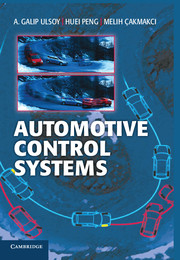Book contents
- Frontmatter
- Contents
- Preface
- Part I Introduction and Background
- 1 Introduction
- 2 Automotive Control-System Design Process
- 3 Review of Engine Modeling
- 4 Review of Vehicle Dynamics
- 5 Human Factors and Driver Modeling
- Part II Powertrain Control Systems
- Part III Vehicle Control Systems
- Part IV Intelligent Transportation Systems
- Appendices
- Index
- References
4 - Review of Vehicle Dynamics
Published online by Cambridge University Press: 05 June 2012
- Frontmatter
- Contents
- Preface
- Part I Introduction and Background
- 1 Introduction
- 2 Automotive Control-System Design Process
- 3 Review of Engine Modeling
- 4 Review of Vehicle Dynamics
- 5 Human Factors and Driver Modeling
- Part II Powertrain Control Systems
- Part III Vehicle Control Systems
- Part IV Intelligent Transportation Systems
- Appendices
- Index
- References
Summary
Design of control systems for ground vehicles must start from an adequate understanding of their dynamic behavior. Although a detailed discussion of vehicle dynamics is beyond the scope of this chapter, simple dynamic models suitable for controller design are necessary for control studies and are developed and presented herein. These simple models are used in subsequent chapters as the basis for controller designs (e.g., cruise control, antilock brakes, traction control, steering control, and active suspensions). More complex (i.e., nonlinear, high-order, and fully coupled) models for vehicle dynamics often are needed to evaluate, using simulation studies, the controllers that are designed using simple control-design models. Such complex models are discussed in detail in the literature (Ellis 1966; Gillespie 1992; Segel 1990; Venhovens 1993; Wong 2008) and also can be implemented in commercial dynamic simulation software (e.g., ADAMS and CARSIM).
First, the standard notation and terminology for vehicle dynamics is introduced with definitions of reference frames and coordinates used to describe vehicle motion. Next, the longitudinal motion of the vehicle, including braking and acceleration, is presented. Then, lateral-motion dynamics, or vehicle steering or handling, is described. Finally, the vertical motion of vehicles is discussed.
- Type
- Chapter
- Information
- Automotive Control Systems , pp. 54 - 92Publisher: Cambridge University PressPrint publication year: 2012

